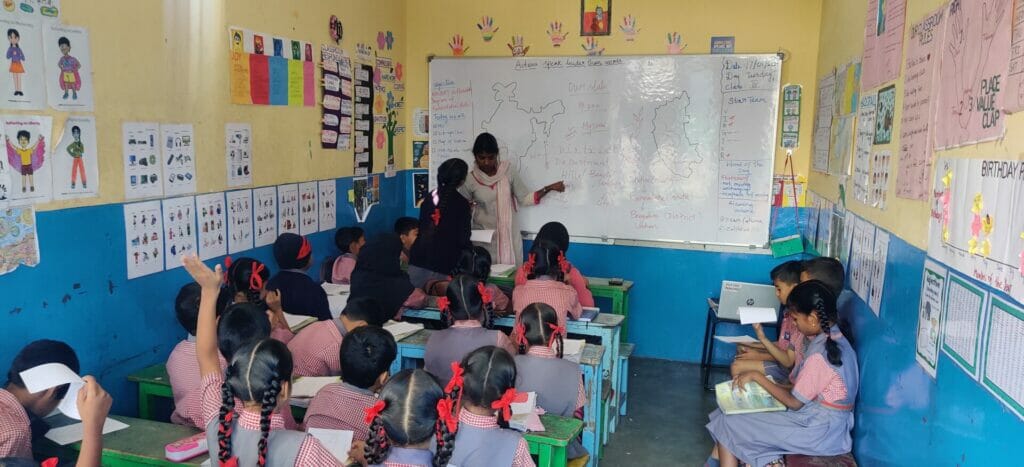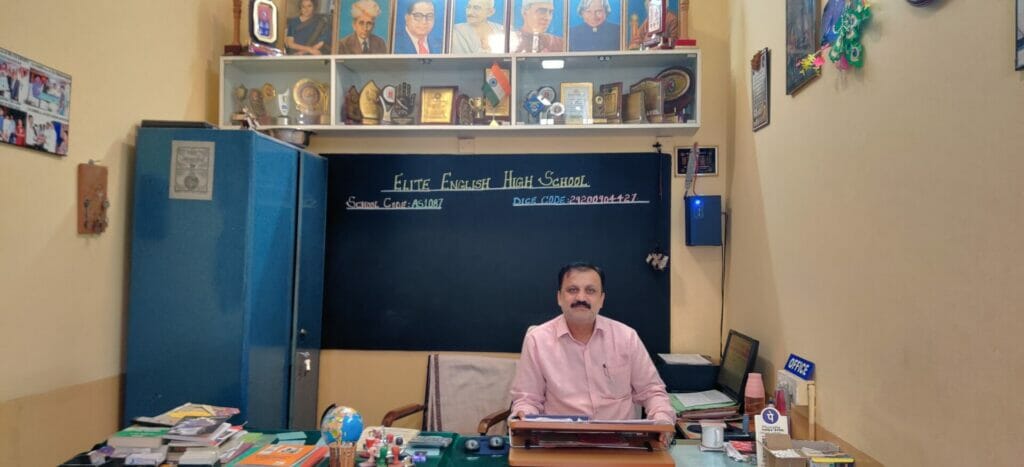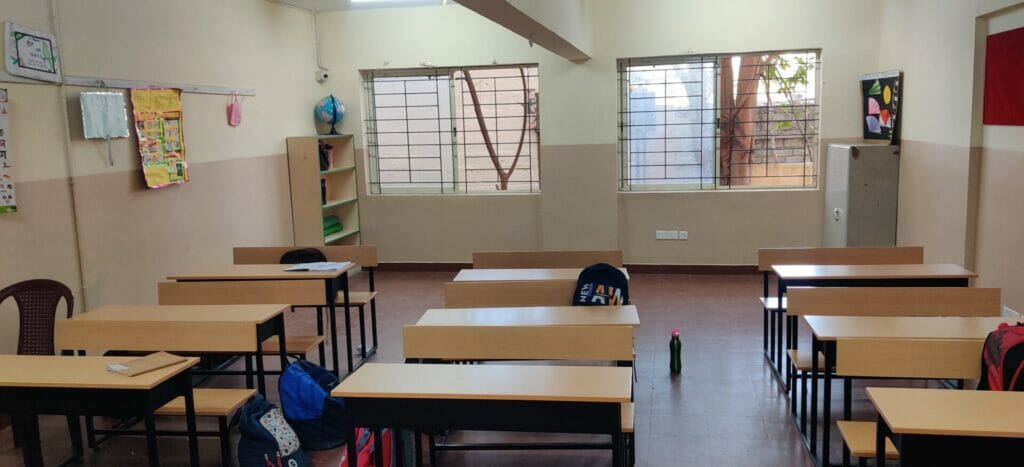Swahlaya Sufi, 13, an eighth grade student at Elite English High School, Neelasandra, dreams of becoming a doctor. Unlike most of her classmates, who were revising for their class quiz, Swahlaya, who stays with her parents in the city but originally hails from Odisha, was calm and well prepared when I met her.
Sakline Abbas, Secretary of Elite English High School, a low cost private school that aims to provide quality education to children from economically weak backgrounds, is impressed with Swahlaya’s calibre. Abbas, had started the school with his wife Sakhina, the current Principal, in 2000.
Read more: Students in this govt school excel against all odds
Irrespective of the examination board, parents often prefer sending their wards to a private school if they can afford it. There are different tiers of private schooling with monthly tuition fees ranging from Rs 800 to Rs 60,000. Among these, schools following the state SSLC board are more affordable than schools that have CBSE and ICSE boards.
The limited number of government schools and their minimal facilities often drive the urban poor to enrol their children in low cost private schools. Their perception is that private institutions provide better opportunities.
I visited two low cost private schools in the city and interacted with the management, teachers, and students there. I also spoke to teachers from two other low cost private schools.
An overview
It was the first period of the day and the fourth graders of Elite English High School were studying the map of Karnataka. The students, eager to answer the teacher’s questions, raised their hands enthusiastically to win a point for the bench if they got the right answer.

“They struggle a little with their academics, but they are making progress,” says a Teach For India (TFI) Fellow in the same school. “If we put an extra effort and teach they learn things. They are ready to learn.” Most of the students attending this school live in the neighbourhood, comprising mainly the urban poor.
Most parents, who send their children to this school, work as house helps, auto drivers, plumbers, and other low income professions. Though they understand the need to educate their children, they aren’t able to provide any academic guidance to their kids. Making the school’s teachers the only source of academic guidance for these children.
Yugina Sudan, a Program Manager with TFI, says that the ‘gap to grade’ is quite high for the eighth and ninth graders in this school. In each grade, students are supposed to be at a particular literacy standard, which is checked by reading comprehension levels. The gap between what is expected in a particular grade and the actual level of the students is called ‘gap to grade’.
“The current TFI team, along with the school teachers, constantly encourage the students and we’ve seen immense growth in their reading levels,” says Yugina. “They are also doing everything in their capacity to ensure the students are able to do well in their board exams by the time they reach tenth grade.”
The school has about 450 students, from kindergarten to tenth grade, with 16 teachers, excluding TFI Fellows. The average class strength is 40 students and the average pass percentage in the SSLC examination, over the years, has been between 80% and 82%, not far behind the state average of 85.63%. “The students are very bright,” says Abbas. “They need to be guided in the right way and Teach for India is doing an excellent job.”

D Ventakesh, Secretary of Little Angels Modern High School, Bennigana Halli, believes education shouldn’t be affected due to inability to pay school fees. With an average class strength of 20 students in each standard, this school has seen 100% pass results in the SSLC examination in most years.
Apart from admitting students coming from low income families, the school also shows the way forward in inclusivity as they take in at least three children who are autistic or have learning disabilities, in each standard.
Children with special needs have an assigned individual called the “Shadow”, who is always with them. While these children learn the same syllabus, they can choose to study only English and opt out of regional languages. Also studying sciences is optional. A separate question paper, set by a special educator, is prepared based on the learning levels of these children. Separate rooms are available for these children to take a break as and when they feel necessary.
Read more: How have government schools fared in terms of enrolment and dropout?
Teachers are facilitators today
“These days teachers are not teachers anymore, they are facilitators,” says Venkatesh. “They only have to guide students. We are focusing more on self learning and research and independent studying by the student.”
Venkatesh explains that his teachers are regularly up-skilled with special trainers coming in to observe their performance and provide constructive feedback. “We monitor our teachers’ performance because at the end of the day it is our core competence.”
Sports and non-academic education
The students of Elite English High School are making the best of what they have. Due to space constraints in their school campus, the children use the nearby BBMP grounds to practice football along with their coach before attending school. Football trainings, matches, and equipments are provided by various organisations. Yoga, volleyball, badminton, and basketball are other sports that the children are encouraged to participate in.
Like several other schools in the city, Elite English High school students participate in Prathibha Karanji, the annual inter school literary and cultural event. The school is proud to have a district level ghazal singer in their midst. Students also engage in various science, arts, drama and dance activities, conducted by an NGO. Field trips to an architecture firm and an MNC were recently conducted for the students.
An inter school volleyball tournament is organised by Little Angels Modern High School every year. In addition to this, the school participates in various inter school sports events.
Sowing seeds of civic consciousness and empathy
Bala Janaagraha is a civic learning programme, which aims to empower and enable children as active citizens. Through this programme, the children participate in local governance and ensure civic amenities are in place. Students from Elite High School were active participants and received awards and accolades under the programme before the pandemic struck.
The service road in C.V. Raman Nagar was fixed by the Bala Janaagrahas of Little Angels Modern High School. In addition to this, students of this institutions were instrumental in greening their school neighbourhood and nearby park. In fact, the school is a green campus, where waste generated is recycled and the entire school runs on solar energy. “We don’t rely on BESCOM anymore because the entire school is solar powered, ” says Venkatesh.
Students also visit orphanages and old age homes to spend quality time with residents there. Through the Interact Club by Rotary, students are involved in community service and nurturing their leadership qualities. The children are also actively involved in Scouts and Guides.

Assisting parents in their ward’s education
As the parents of students in both these schools find it difficult to help their wards, they generally resort to private tuitions at home. However, in most cases this ends up burdening the students mentally and the parents financially.
“We have parent-teacher meetings every month and 90% of the parents attend them,” says Abbas. “There are a few parents who work as house helps and cannot make it on time. But then we ensure they meet the teachers regularly.”
Venkatesh explains that even though uneducated parents do not understand the homework, they ensure it is completed by their children. Teachers communicate regularly with parents through Whatsapp. “It is not economic disparity or education of the parent that act as factors here, rather the interest taken by the parents in their child’s studies and activities,” says Venkatesh.
Fees and scholarships
The annual fees in Elite English High School is Rs 28,000 for tenth grade. At Little Angels Modern High School, it is around Rs 35,000. The fees in both schools are inclusive of tuition fee, books, and uniforms.
Scholarships and fee concessions are given to students. Minority scholarships, fee concessions are given to parents with two or three children studying in different grades in the school, single parents, and others living in extreme poverty.
Donations from NGOs and individuals are distributed to deserving students, according to Abbas. During the pandemic, the school distributed tablets that were given by an NGO.
“Some of our students receive Rotary scholarships. Sometimes, financially able parents donate money and the members of the management chip in to bridge the financial gap,” says Venkatesh.
Libraries and labs in place
Venkatesh showed me around his school. I visited the library, computer lab, science lab, audio-visual room, literature lab, where literary competitions are held, the playground, and the spacious classrooms. Science exhibitions are conducted to encourage children to understand its applications in daily life. The school has ample space to accommodate more students and they hope to include 11th and 12th grades in the coming years.

Elite English High School has a small library that was set up with the support of TFI Fellows. The library contains a large variety of books that meet the needs of all students and provides ample resources to students and teachers. An audio visual room and a computer lab are in place to facilitate better learning. Laptops and computers have been donated.
With hope in his eyes, Abbas says he is waiting for a new computer lab as promised by an NGO. However, space is a constraint with classrooms only big enough to house the current strength of each class. Abbas explains that he hopes to expand if the New Education Policy (NEP) requires him to include 11th and 12th grades.
“To ensure that there are good opportunities for students to learn better hands on, the school has well-equipped physics, chemistry and biology labs and other learning spaces. The school’s three computer labs in school have updated systems and laptops for all students.”
“The art and pottery room, music room, and sports rooms are fully functional and efforts are made to ensure that everything available there is upto date and function smoothly”, says Tejas R, who teaches classes 10th to 12th in a private school run by an NGO in Yelahanka. The school, whose students belong to poor and other deprived communities, aims to bridge the education gap.
Read more : How community learning centres are bridging the gaps in Bengaluru’s education infrastructure
Facing the real world
Employability should be one of the key outcomes of education. The education system, so far, has been more inclined to imparting theoretical knowledge without giving enough room to enhance the practical skills of students based on their interests and aptitude. Venkatesh hopes the introduction of NEP will resolve this issue and bridge the gap between the different school boards.
“Be it the state board, CBSE, ICSE, there is not much difference in the skills imparted to the students,” says Annie, a teacher from a private school in Rajajinagar. The economic and social backgrounds of these children will differ, but when it comes to facing the real world, there isn’t any difference.”
“When we look at the students and their peers across other schools, they are capable of being on par with any student of that age,” says Tejas. “Students have their own preferences and they are capable of expressing their views. They are also logically sound, which reflects in the ways they are able to articulate and respond to complex subjects like maths and science. Of course, their perspectives are a bit narrow due to the communities they come from, but we can see examples of how students are showing exemplary progress in broadening their thought.”
Abbas proudly says that some of his former students are engineers and chartered accountants today. Each year he invites and felicitates SSLC toppers of the previous academic year during the graduation ceremony of the current tenth grade batch, in the hope to inspire both groups to pursue further education. He notes that though girls perform better than boys, they often drop out of college and get married. He counsels parents and the community to encourage their daughters pursue higher education.
Right to Education
The Right to Education (RTE) Act 2009 is meant to ensure compulsory and free education for all children between the ages of six and 14.
Sanjana, a third grader, is in school today only because of this right conferred by the Act. She attends a private school barely ten minutes from her home. Her mother, Lakshmi, is a domestic worker. While Sanjana’s tuition fee is met through RTE, Lakshmi has to spend around purchasing study material, uniforms, identity card, etc. Lakshmi has to set aside around Rs 15,000 a year from her meagre salary to ensure her daughter is schooled well.
At Little Angels Modern High School there are 10 to 12 students who come in through RTE. Unlike Lakshmi, their parents aren’t required to pay anything.
At a time of concerns over declining learning levels, these schools show that children’s education can be enhanced.